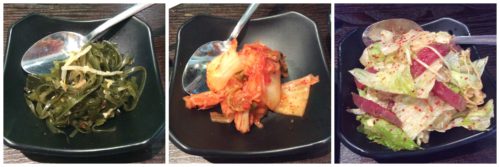We were sent a Katto santoku knife for review. All images and opinions are our own.
I’ve just got back from a week in a holiday cottage in Wales. Getting away gives us the chance to shake off the 9 to 5 and spend more time doing the things we enjoy, like cooking. As a busy mum, our evening meals are hastily thrown together, and are designed to provide as much nutrition as possible, as quickly as possible. I am horribly bored of our mid-week meals, so a holiday is a chance to change gear and spend a bit more time in the kitchen cooking nice meals. The problem with holiday cottages is their kitchens can be basic, and their knives are invariably woeful. Whenever we go away, foodies that we are, we always pack a decent pan or two and a couple of good knives. Last week I packed our new Katto santoku knife, and we were determined to put it through its paces.

When I left home, my Dad bought me a set of chef’s knives, and they’ve stood me in good stead for the last 20+ years. Occasionally I’ve bought a new knife but they never last, and if I’m honest, I think you need to spend good money to get good knives. I’ve been thinking about getting a Japanese style knife for a few years now, but I’ve struggled to find something which fit my budget and my knife-based needs.
Katto knives are handmade in the UK. Their knives combine super sharp Japanese steel blades with hand-carved wooden handles. They are beautiful, beautiful knives and just owning one makes me want to spend more time in the kitchen.

The Katto website is full of great looking knives and other kitchen accessories. There’s also a knife quiz which can help you choose the right knife for you, something which I found really useful.
I opted for the Katto santoku knife which is a straight edged and ‘sheep’s foot’ blade. Santoku knives were originally designed to perform three tasks in Japanese kitchens – mincing, dicing and slicing. The Katto santokus come in three distinct handle styles – Henry (black walnut), Nala (beech) and Olivia (rosewood). I opted for the Henry, as I just liked the look of it. The price you pay for your knife depends on the finish you’re going for. I’d recommend also buying a scabbard for it, as it’s really sharp and it’s not a knife I’d like lurking in my kitchen drawer unsheathed.

On holiday we ate incredibly well. I’m a veggie who probably doesn’t eat enough veg, so we spent many happy evenings in the kitchen chopping, slicing and dicing vegetables and creating wonderful dishes with them. From shakshuka, to Cantonese scrambled eggs, Thai green curry and simple but veg heavy pasta dishes. We ate and we ate well. Our Katto santoku knife was a revelation. It was so well balanced and comfortable to use. It was sharp and sliced through everything we put it to with ease. The Katto santoku knife was a joy to use, so much so that there was the occasional tussle over who got to chop and who got to stir.
You can see the knife in action over on Instagram here.

Keeping a knife like this is good condition can be daunting, but they offer free sharpening in London, and you can always buy a whetstone from them. There are videos on their website which walk you through how to care for your knife and sharpen it when the time comes. It’s not the kind of knife you just throw in the dishwasher, just wash it gently with soap and water, dry it and pop it back in its scabbard for safe keeping.
I can’t say that this knife is going to revolutionise my mid-week meals, but it probably will speed up the process a little. I am hoping the knife will make our more leisurely weekend meals more enjoyable to prepare. It has changed how I view all the other knives in my drawer, and I suspect over time they will be replaced with other knives from Katto. If you spend any significant time cooking, then it’s a huge game changer to be using really good quality knives. I don’t think I can go back now.
For more information about Katto knives and their other kitchen accessories, visit their website.






